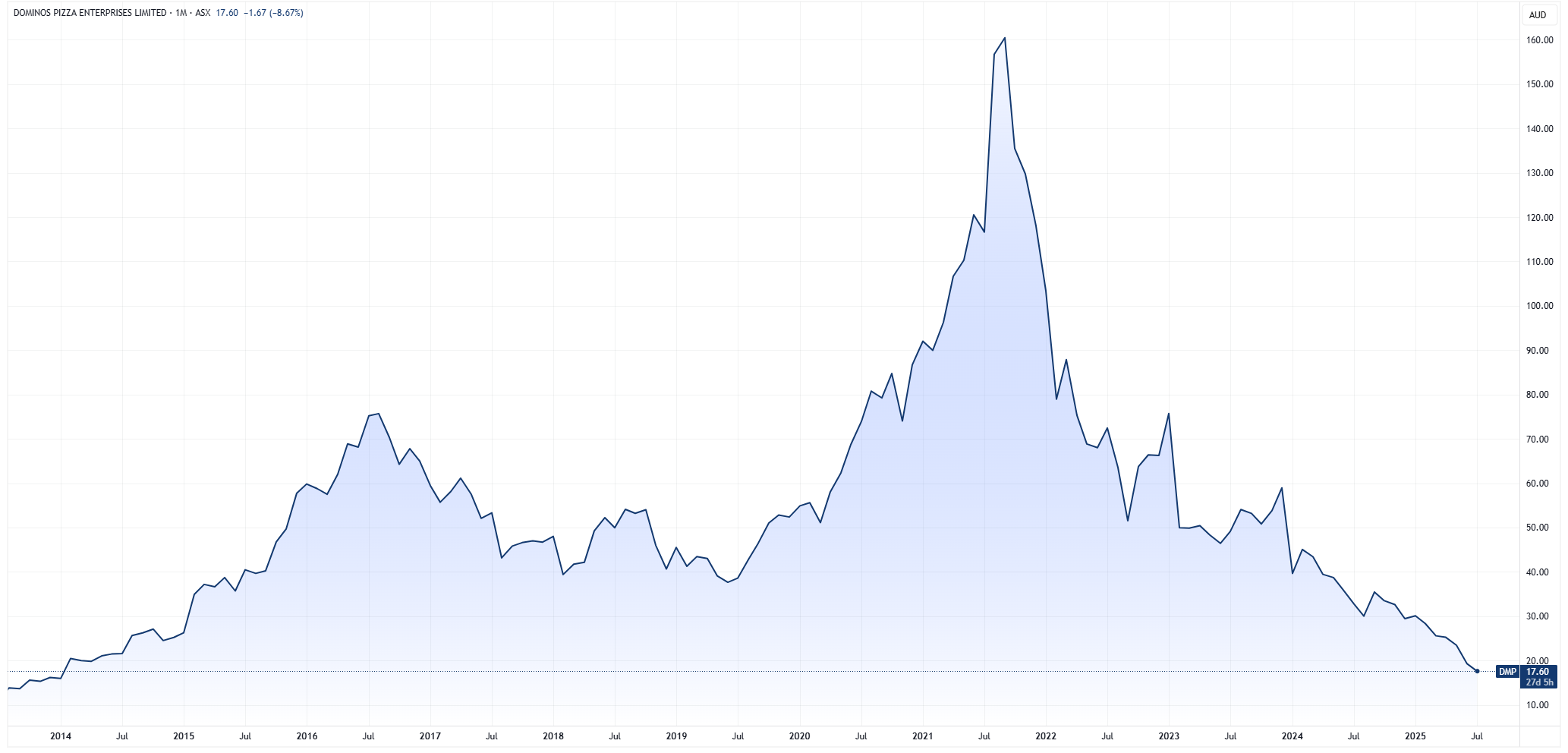Domino's Pizza: How a $150 stock became a $15 disaster
Shares in Domino's Pizza (ASX: DMP) crossed the $150 level in September 2021. On Wednesday, it briefly traded below $15, a staggering decline that has effectively wiped an entire zero off the share price.
In less than four years, the pizza chain has erased roughly 90% of its market cap, representing one of the most dramatic falls from grace among S&P/ASX 200 companies. This isn't a momentary blip or stroke of bad luck, but rather the systematic erosion of shareholder value driven by a deterioration across all aspects of the business (and terrible pizzas).

The collapse stems from multiple structural issues that have compounded over the past couple of years.
- Over-expansion and poor returns: Domino's pursued aggressive store expansion, particularly in Japan and Europe, later acknowledging it had "expanded too quickly in some regions." The company has since begun rationalising its store footprint, but the damage was done. If you look at the company's 'Financials' tab on Market Index, you'll observe ROE and ROA deterioration over the medium term.
- Falling same store sales: The key retail metric of same-store sales has consistently underperformed or declined across major regions, signaling fundamental demand weakness rather than temporary setbacks.
- Deteriorating margins: Input costs for labor, rent, and ingredients have soared while pricing power has proven limited. EBIT margins have collapsed from 16-18% in FY17-18 to just 8.6% in the latest first-half FY25 result.
- Consumer pushback: Domino's raised prices to combat cost inflation, but price-sensitive consumers, especially in Japan and Europe, have pushed back hard. The pandemic tailwinds that once boosted the business have fully reversed as growth normalised post-lockdown.
Recent Earnings
The deterioration has accelerated through recent earnings disappointments:
First-Half FY25 results (February 25, 2025): Shares tumbled 10.5% as sales momentum concerns intensified. While ANZ operations outperformed, Europe and Asia under-delivered, with Japan and France remaining particularly weak. Franchisee profitability stayed below management's long-term targets despite cost-saving initiatives, as benefits were reinvested rather than flowing to shareholders.
FY24 results (August 21, 2024): Although key metrics met expectations, the trading update and FY25 guidance fell short of consensus, triggering further analyst downgrades. This marked the ninth downgrade to consensus estimates over three years.
Leadership Exodus
Wednesday's leadership announcement delivered what many view as the final blow to investor confidence. CEO Mark Van Dyck will step down effective December 23, 2025, after serving less than a year in the role. This caps an exodus of senior leadership:
- Japan CEO Martin Steenks transitioning to COO with search underway for local leadership (June 2025)
- ANZ CEO Kerri Hayman resignation (May 2025)
- Group CFO Richard Coney retirement (February 2025)
- Longtime CEO Don Meij retirement (November 2024)
Van Dyck's key initiative involved delivering immediate cost savings, including closing 205 loss-making stores as part of a comprehensive review. However, his premature departure, without the customary trading update that typically accompanies July announcements, suggests the company may be withholding unfavorable news ahead of its FY25 results.
Conference Call Takeaways
Domino's hosted an executive chairman Q&A, which left analysts more cautious on the path moving forward. According to Morgan Stanley, Mr Dyck's resignation was voluntary and stemmed from a misalignment with the board on the pace of strategy implementation.
Citi analysts also attended the session, noting a few key takeaways including:
- Cautious outlook: Domino’s turnaround hinges on improved execution, but recent performance and franchisee profitability challenges raise doubts about achieving the targeted 3% same-store sales (SSS) growth within 12 months.
- Cost-cutting focus: With $90 million already cut over three years, further cost reductions risk impacting customer experience or franchisee services. However, a substantial portion of the savings will support franchisees.
- Balance sheet review: The executive chairman claims a solid balance sheet (gearing at 2.5x, expected to decrease by year-end), with no immediate need for a capital raising.
- Shift in competitive strategy: Domino’s acknowledges its technological advantage has eroded, plans to reduce IT spend by adopting third-party systems, and aims to compete on scale rather than proprietary technology.
Where to From Here?
The selloff represents a complete purge of investor confidence. The CEO is leaving after less than a year at the helm, at a time where sales continue to slow, cash flows are dwindling and there's been little change in franchisee profitability.
While periods of extreme fear typically coincide with market bottoms, there are very few reasons to turn bullish on Domino's. The latest half-year FY25 result still highlighted a struggling company, notably:
- Group comparable sales decelerated from 4.3% in the first five weeks of 2H25 to just 1.5% in the first seven weeks
- Limited strategic commentary on improving sales and profitability in challenged markets
- Group free cash flow plummeted 53% year-on-year to just $30 million
Despite the carnage, most analysts see upside potential from depressed valuations, but are cautious on current uncertainties including execution risk, muted visibility on near-term earnings and the importance of appointing (and keeping) a credible CEO.
- Goldman Sachs: Maintained Buy, target remains $37.30. CEO departure seen as premature and destabilising with uncertainty elevated ahead of key strategy event.
- RBC Capital Markets: Maintained Sector Perform, target lowered to $18 from $30. Leadership volatility undermines strategic credibility with European and Asian headwinds viewed as structural.
- Jefferies: Maintained Buy, target remains $42. Market reaction seen as overly punitive short term, with balance sheet viewed as manageable despite volatility.
- CLSA: Downgrades to Hold from Outperform, target lowered to $15.10 from $40.10. Strategic clarity delayed until new CEO appointed with departure signaling internal disarray.
The Verdict: A Likely Value Trap
At current levels, Domino's is brutally oversold and trading on a forward P/E of around 15x versus 27x a year ago. However, this apparent value opportunity masks a company trapped in structural decline with no credible turnaround strategy.
The fundamental problems remain unresolved: same-store sales continue declining, margins are under pressure, and franchisee profitability stays below target. With leadership in chaos and key markets like Japan and Europe facing structural headwinds, Domino's faces a mountain of challenges that cheap valuations alone cannot overcome.
While the company maintains a manageable balance sheet with net debt at 2.3x EBITDA and retains meaningful scale, these strengths could provide significant leverage if the business begins to recover. However, until new leadership can articulate a clear path to sustainable growth and margin recovery, Domino's remains a classic value trap – cheap for good reason.
This article was first published on Market Index on Friday, 4 July 2025.
1 topic
1 stock mentioned

